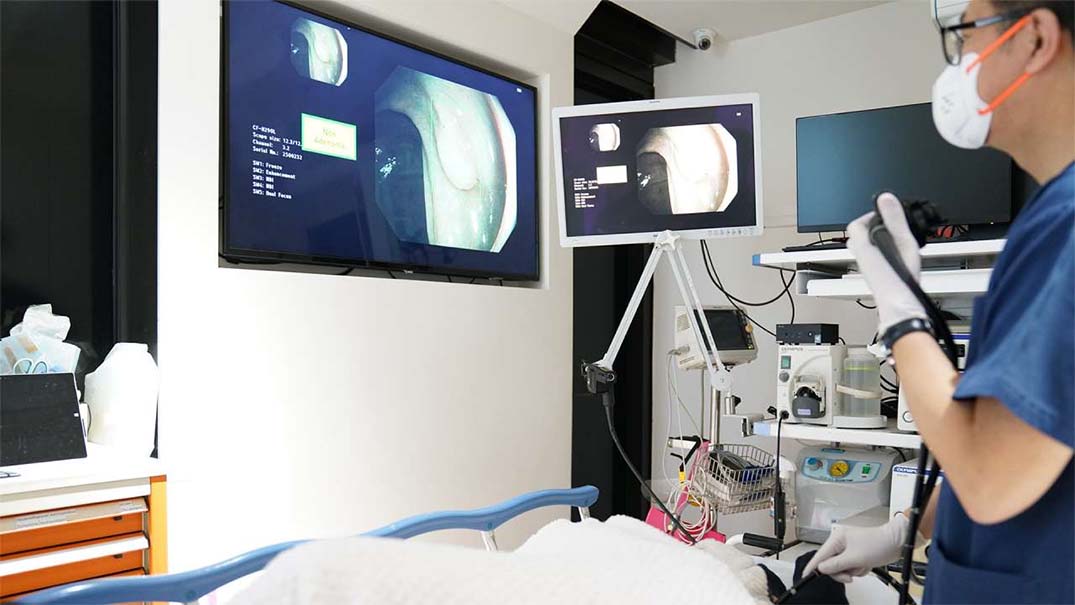Colorectal cancer is the third most-common cancer worldwide, with almost 2-million new cases detected in 2020, according to World Cancer Research.
While diagnosing colon-related cancers is a relatively straightforward procedure – most adults will undertake a colonoscopy by the time they’re 60 – spotting abnormalities along all 6 feet of the large intestine is still a labour-intensive process.
Backed by years of experience, doctors performing the procedure rely on a steady hand, sharp eyesight and unwavering attention to detail.
But you’re still dealing with humans – and that means errors. Detection rates for adenomas, a type of growth along the colon wall, tend to decrease through the course of the day.
That’s largely due to human-related causes, according to a 2018 study, as operators rush procedures or because of plain human fatigue.
And the risk of a miss is alarming in even a small percentage of cases when you consider as many as 15-million colonoscopies are performed in the US each year, according to CNN.
Help is here, thanks to a collaboration between Asus and Intel: An AI-boosted solution spots adenomas in mere milliseconds, often before the human eye can.
Launched in November, the Asus EndoAim AI Endoscopy System is about as large as the palm of your hand. It sits unobtrusively in a colonoscopy room, blending into the background and clutter of other, larger medical equipment.
It feeds video data from the colonoscopy camera through an ASUS mini PC running on an 11th Gen Intel Core processor (code-named Tiger Lake) and outputs the result at 60 frames per second.
The solution tags suspected polyps and other abnormalities on the screen by bracketing them in green, and immediately classifies the polyps, saving medical staff the guesswork.
And it doesn’t just tag a single polyp at a time. Asus claims that in clinical trials, EndoAim can bracket up to 50 polyps in realtime.
Results aren’t confined to clinical trials.
Late last year, a Taiwan doctor using an early version of EndoAim explained how it helped him detect eight polyps simultaneously during a routine colonoscopy.
In early March 2023, another doctor thanked EndoAim for helping him locate a 0,3-centimeter adenoma hidden in the deepest part of a patient’s large intestine.
Today, Asus EndoAim is used at five medical facilities in Taiwan, including the Kaohsiung Veterans General Hospital, the National Yang Ming Chiao Tung University Hospital, Dianthus Medical Group, Dr Lee Clinic and Ansn Clinic.
Intel engineers helped Asus fine-tune their AI solutions to detect the tiniest polyp on a wide array of Intel open source software, including OpenVino toolkit.
The ability to seamlessly and quickly write code to accelerate the system’s development and bring it to market in less than two years “played a crucial role in bringing our vision to life,” says April Yang, project manager: EndoAim at Asus.
“Our goal is to showcase the effectiveness of EndoAim in Taiwan and emphasise how AI can truly assist physicians. Just like advanced driver-assistance systems in cars, AI does not replace the physicians but serves as a reliable backup, enabling high-quality inspections,” Yang explains, adding that EndoAim differentiates itself from other AI-boosted solutions by offering real-time polyp detection with up to 95% sensitivity and the ability to classify polyps with up to 95% AUC (a type of performance measurement in machine learning models).
“Ultimately, we aim to help doctors increase the polyp detection rate during scope-related procedures and to help them make accurate evaluations that avoid unnecessary tissue biopsies.”
When Asus engineers began developing this solution in 2021 with advanced AI computing technology integrated into a large tower-based PC chassis, they quickly realized space was a huge constraint.
Intel suggested the 11th Gen CPU family. The Intel CPUs feature Intel Iris Xe Graphics tech that provides discrete-level integrated graphics.
“With OpenVino, ASUS found out that they were able to achieve 60 frames per second detection rate within a compact Intel CPU. That also means lower cost, and they were able to enable a fanless design as well as a smaller footprint, which makes the portability possible,” explains Tasha Chuang, director of the Asus global account team at Intel Taiwan.
ASUS and Intel are exploring new opportunities to further enhance EndoAim by boosting its display output and computing prowess, and to expand the technology into other medical areas.
“We need more computing power and are currently testing Intel’s 13th Gen processor family now,” says Yang, explaining how ASUS is looking to evolve future solutions with higher 4K resolutions.
“We’re also exploring the ability to add more functionality that doctors and medical staff will find useful, and we look forward to collaborating with Intel in this area. This is just the beginning.”

